PCBONLINE provides turnkey PCB (printed circuit board) manufacturing and assembly, including box-build assembly services after the PCB is fully assembled with surface mount and through-hole components. During box-build assembly, we mount the PCBA in an enclosure. The PCB enclosure we use for box-build assembly is custom-designed and manufactured, exactly matching the size and function requirements of the PCBA.
Please note that we do not manufacture the PCB enclosures but have them manufactured by our mold partners. We maintain long-term cooperation with the top 3 enclosure factories in China.
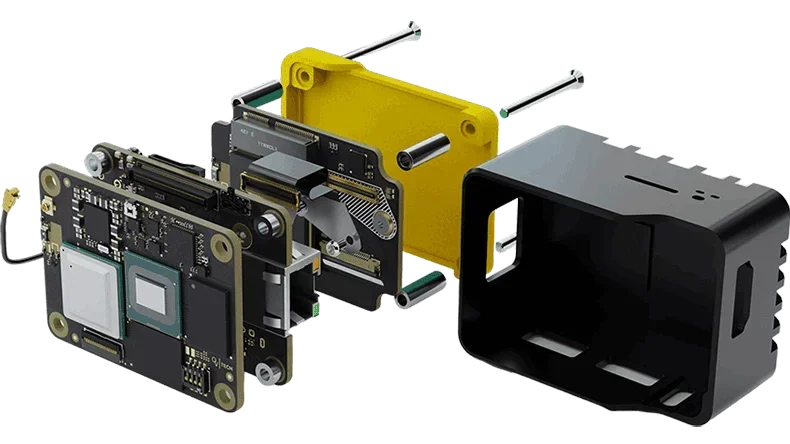
What is a PCB Enclosure
After the PCB is fully assembled and tested, it enters system integration, requiring installation into an enclosure to provide structural support, environmental protection, electromagnetic shielding, and other functionalities.
Unlike standard enclosures, the PCB enclosures used for business, such as automotive, industrial, and medical applications, are custom-designed and molded. They should be precise. Here is a systematic breakdown of PCB enclosure material types, functional requirements, and design considerations.
PCB Enclosure Materials
The common PCB enclosure materials include ABS plastic or aluminum alloy. However, there are more materials used.
|
Enclosure material
|
Characteristics
|
Application scenarios
|
|
ABS plastic
|
Low cost, easy to mold, good insulation. Can be surface-painted/plated.
|
Consumer electronics, household appliances.
|
|
PC (Polycarbonate)
|
High impact resistance, high temperature resistance. Can be transparent.
|
Industrial controllers, medical equipment.
|
|
ABS + PC alloy
|
Combines toughness with good aesthetics. Can be flame-retardant.
|
Smart home devices, in-vehicle equipment.
|
|
Aluminum alloy
|
High strength, excellent thermal conductivity. Provides EMI shielding.
|
Industrial controllers, communication equipment.
|
|
Magnesium alloy
|
Lightweight, high-strength.
|
High-end portable devices.
|
|
Stainless steel/iron housing
|
Sturdy, corrosion-resistant, strong shielding capabilities.
|
Power supply units, medical or military electronics.
|
|
Silicone or rubber overmolding
|
Shock absorption, non-slip grip.
|
Portable, outdoor devices.
|
|
Fiberglass reinforced plastic (FRP/GF-Nylon)
|
High strength, good weather resistance.
|
Outdoor industrial instrumentation.
|
PCB Enclosure Functional Requirements
PCB enclosures should meet device requirements, such as EMI shielding for RF devices, waterproof for underwater lights, etc. Below, you can find the different functional requirements for PCB enclosures used for different design purposes.
|
Enclosure Function
|
Design purpose
|
Implementation methods
|
|
EMI shielding
|
Suppress electromagnetic interference and leakage.
|
Conductive coating, metal housing, shielding cans, and grounding spring contacts.
|
|
Water/dust protection (IP rating)
|
Protect internal PCBA.
|
Sealing gaskets (O-rings), waterproof breathable membranes, and ultrasonic welding.
|
|
Heat dissipation
|
Prevent component overheating.
|
Heat sinks, thermal paste, aluminum housing, heat pipes.
|
|
Mechanical strength
|
Prevent damage from drops/vibration.
|
Rib designs, cushioning materials, rubber corner protectors.
|
|
Electrical safety/insulation
|
Prevent electric shock or short circuits.
|
Insulating plastics, internal partitions.
|
|
Aesthetics and HMI
|
User experience.
|
Painting, plating, silk-screening, cutouts for touch buttons, etc.
|
Design Considerations for PCB Enclosures
When you design an enclosure for a PCB, the PCB enclosure assembly method, heat dissipation and ventilation, grounding and shielding, protection level, and environmental certification are what you need to consider.
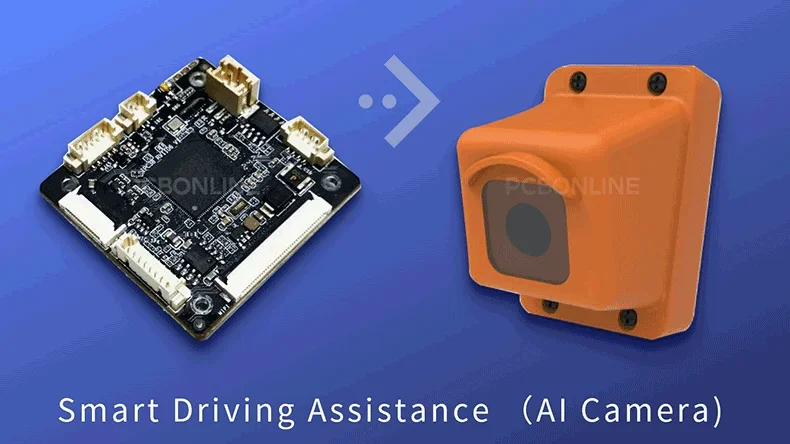
PCB enclosure assembly methods
The PCB enclosure assembly method of the enclosure directly impacts the product's structural strength, ease of maintenance, and protective performance. PCB enclosure assembly methods include screw fastening, snap-fit, slide-in, and ultrasonic welding.
1. Screw fastening
Pros: High reliability, sturdy structure, easy to disassemble and maintain.
Cons: Appearance can be slightly industrial, and longer assembly time
Design tips:
- Use stainless steel or nickel-plated screws.
- Screw bosses should be thickened to prevent stress cracking during injection molding.
- To prevent loosening, use lock washers or thread-locking adhesive.
- Metal casings should include insulating gaskets to prevent PCB shorts.
Applications: Industrial controllers, power supply modules, rack-mounted equipment.
2. Snap-fit
Pros: Fast assembly, clean appearance, suitable for mass production.
Cons: Prone to wear after multiple disassemblies; requires strict tolerance control.
Design tips:
- Recommended use of PC/ABS material for good toughness.
- Hook angle is typically 10° to 15°.
- Snap locations should be evenly distributed to prevent localized deformation.
Applications: Consumer electronics, small home appliances, smart home devices.
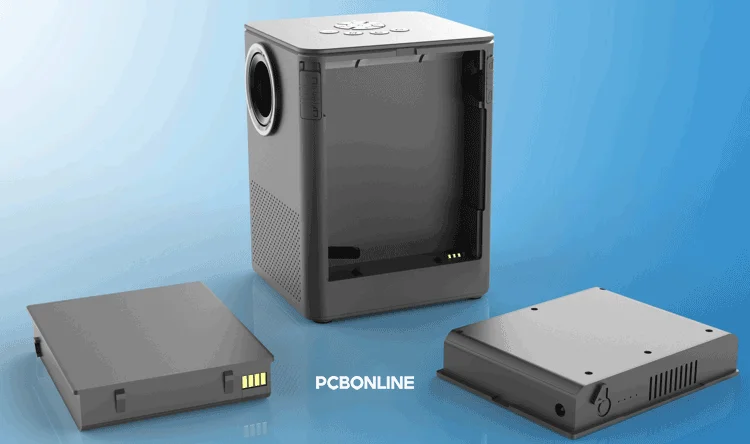
3. Slide-in/rail mount structure
Pros: Simple assembly, no screws required, enables modularity.
Cons: Requires high-dimensional precision; weaker water resistance.
Design tips:
- Common in communication modules and DIN rail equipment.
- Guide ribs can be added to the tracks for easy sliding and positioning.
- Often combined with screws or snaps for final locking.
Applications: Industrial automation, communications racks, power modules, and IoT gateway devices
4. Ultrasonic Welding
Pros: No screws needed, excellent sealing, suitable for waterproof products.
Cons: Non-dismountable, requires specialized equipment.
Design tips:
- Contact surfaces must include an Energy Director for welding.
- Applicable to thermoplastics like ABS, PC, and PP.
- Often used for enclosures with an IP67 or higher rating.
Applications: Outdoor sensors, medical electronics, smart wristbands.
PCB enclosure thermal and ventilation Design
The enclosure is important for thermal dissipation of the electronic system or device, so its thermal and ventilation design deserves consideration in your design. Here is our thermal design explanation for the common aluminum alloy and plastic enclosures.
1. Aluminum alloy housing
Short thermal path: Heat can be conducted directly to the exterior through the casing.
Surface treatment: Anodizing enhances corrosion resistance and thermal conductivity.
Common accessories:
- Thermal pad (thermal interface material)
- Heatsink
- Fin design (for increased surface area)
2. Plastic housing
A plastic enclosure has poor thermal insulation, so it needs additional thermal design:
- Thermal post (copper post) to connect high-heat components.
- Thermal sheet or graphite sheet (graphite heat spreader).
- Internal metal shielding cans (for both heat dissipation and shielding).
If the electronic device or system uses fans or vents, to the plastic PCB enclosure, install a dust filter or a waterproof breathable membrane, and prevent liquids and dust ingress while maintaining pressure equilibrium.
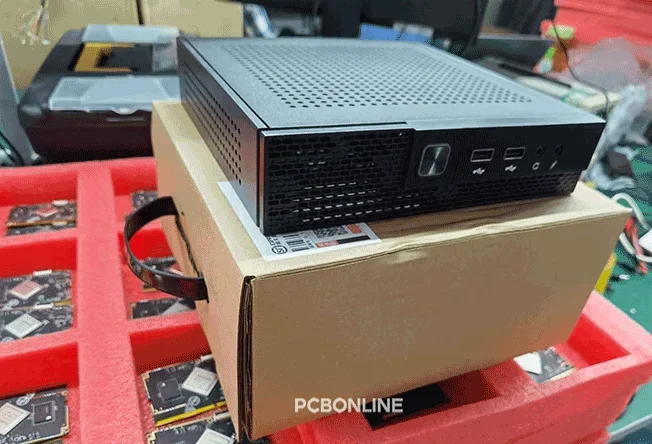
PCB enclosure grounding & EMI shielding design
Electromagnetic compatibility is an important consideration in PCB design, especially for high-frequency PCBs. Both metal and plastic enclosure designs need EMI protection.
1. Aluminum alloy or metal housing
The housing acts as the overall shielding layer. It connects to the PCB ground during assembly via grounding spring contact or screw bosses routed to the ground layer. Its surface must be free of oxidation or treated with a conductive coating to ensure low contact resistance.
2. Plastic housing
Plastic is non-conductive and requires artificial creation of a shielding layer:
- Conductive spraying: Spraying conductive silver, copper, or nickel paint on the inner wall.
- Metal plating: Vacuum deposition or electroless nickel plating.
- Local shielding can: Adding metal cans over critical areas.
The shielding layer must be reliably connected to the system ground. Besides, avoid creating ground loops due to multiple grounding points.
Ingress protection of PCB enclosures
The ingress protection (IP) level of the PCB enclosure means its protection level against solid particles such as dust and liquids, especially water.
|
IP rating
|
Meaning
|
Applications
|
|
IP54
|
Limited dust ingress protection, protected against light splashing water.
|
Indoor industrial equipment.
|
|
IP65
|
Dust-tight, protected against water jets.
|
Outdoor displays, LED drivers.
|
|
IP67
|
Dust-tight, protected against short-term immersion (1m/30min).
|
Smart watches, outdoor sensors.
|
|
IP68
|
Dust-tight, protected against long-term continuous immersion.
|
Diving instruments, heavy industrial equipment.
|
Tips for ingress protection of the PCB enclosure:
- Add silicone O-rings at seams and gaps.
- Use waterproof connectors for critical interfaces.
- Use a gasket + dcrew compression structure at housing joints.
Compliance & standards of PCB enclosures
PCBONLINE is an OEM PCBA manufacturer meeting various standards required by mid and high-end applications. Although we don't manufacture the PCB enclosures by our own, we always supervise our enclosure partners to ensure complete compliance in their molding.
|
Standard
|
Description
|
Application
|
|
RoHS
|
Restricts hazardous substances (Pb, Hg, Cd, etc.).
|
Mandatory for EU markets.
|
|
REACH
|
Regulation on chemical registration, evaluation, and authorization.
|
Material compliance verification.
|
|
UL94 Flammability Rating
|
Standard for material combustion performance.
|
V-0 rating self-extinguishes within 10 seconds of flame removal with no dripping. Used for industrial/power supply enclosures.
|
|
ISO 14001 / IEC 60529
|
Environmental management and protection rating systems.
|
Manufacturer management requirements.
|
Partner with PCBONLINE for PCB Box-build Assembly, Including PCB Enclosures
PCBONLINE is a PCBA original equipment manufacturer providing box build assembly. We provide all the electronics manufacturing and materials used for our PCB box-build assembly services, including the PCB enclosures.
Our OEM PCBA manufacturing services offer:
- Complete procurement: We source and customize enclosures, cables, and accessories from reliable suppliers.
- Engineering support: We check enclosure and accessory designs for compatibility with your PCBA and can suggest design changes.
- Free DFM/DFT: We provide free Design for Manufacturability (DFM) and Design for Testability (DFT) checks to ensure that designs are optimized for a smooth production process.
- Special capabilities: IPX8 waterproof enclosures and encapsulation for rugged outdoor devices.
- Quality assurance: IPC-A-610 Class 3, automotive-grade or industrial-grade inspection standards.
- Turnkey delivery: From PCB fabrication to final product packaging and shipping.
- Testing and value-added services: Offering a range of quality assurance services, including X-ray inspection for hidden-joint PCBAs, first-article inspection, PCBA functional testing (FCT), IC programming, burn-in test, PCBA coating, enclosures, and box-build assembly.
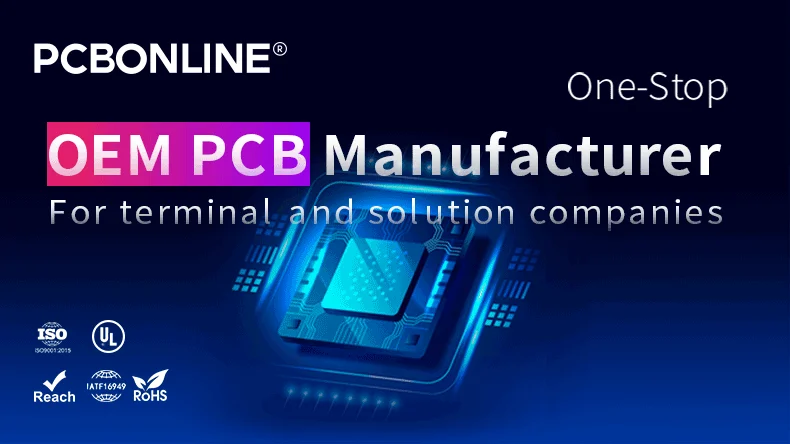
Founded in 2005, our two advanced PCB manufacturing bases are in Jiangsu and Jiangxi Provinces, and our turnkey PCB assembly factory is in Shenzhen. Besides, we have an R&D team and a global supply network. We also maintain strategic cooperation with the top 3 fixture and enclosure factories in China to manufacture the custom PCBA fixtures and device enclosures.
PCBONLINE manufactures, assembles, and tests PCBs and PCBAs to box builds as a source factory manufacturer under one roof, from prototypes to bulky production, saving costs and time for you.
We keep strategic cooperation with the top 3 enclosure manufacturers in China to manufacture custom device enclosures.
We can design the PCB enclosure to match your PCB. Besides, we can help create user manuals, installation guides, and compliance labels.
Our high-quality PCBA contract manufacturing is certified with ISO 9001:2015, ISO 14001:2015, IATF 16949:2016, RoHS, REACH, UL, and IPC-A-610 Class 2/3.
Our one-on-one free and professional DFM helps you debug and improve design, to ensure the manufacturability, cost-effectiveness, and final device success.
Whether you need PCB box builds for consumer IoT devices, creative electronic products, automotive/medical-grade systems, etc, with 20 years of PCBA manufacturing and box build experience, we ensure that both electronics performance and final product presentation meet the highest standards. To get a quote for your box build project, email us at info@pcbonline.com.
Conclusion
This article clearly lists the PCB enclosure materials and function requirements. PCB enclosure design involves not only the structure, but also mechanical, thermal, EMI, ingress protection, and regulatory compliance. Contact us to order a turnkey PCBA or box-build assembly, which includes PCB enclosures, for any mid and high-end applications.




